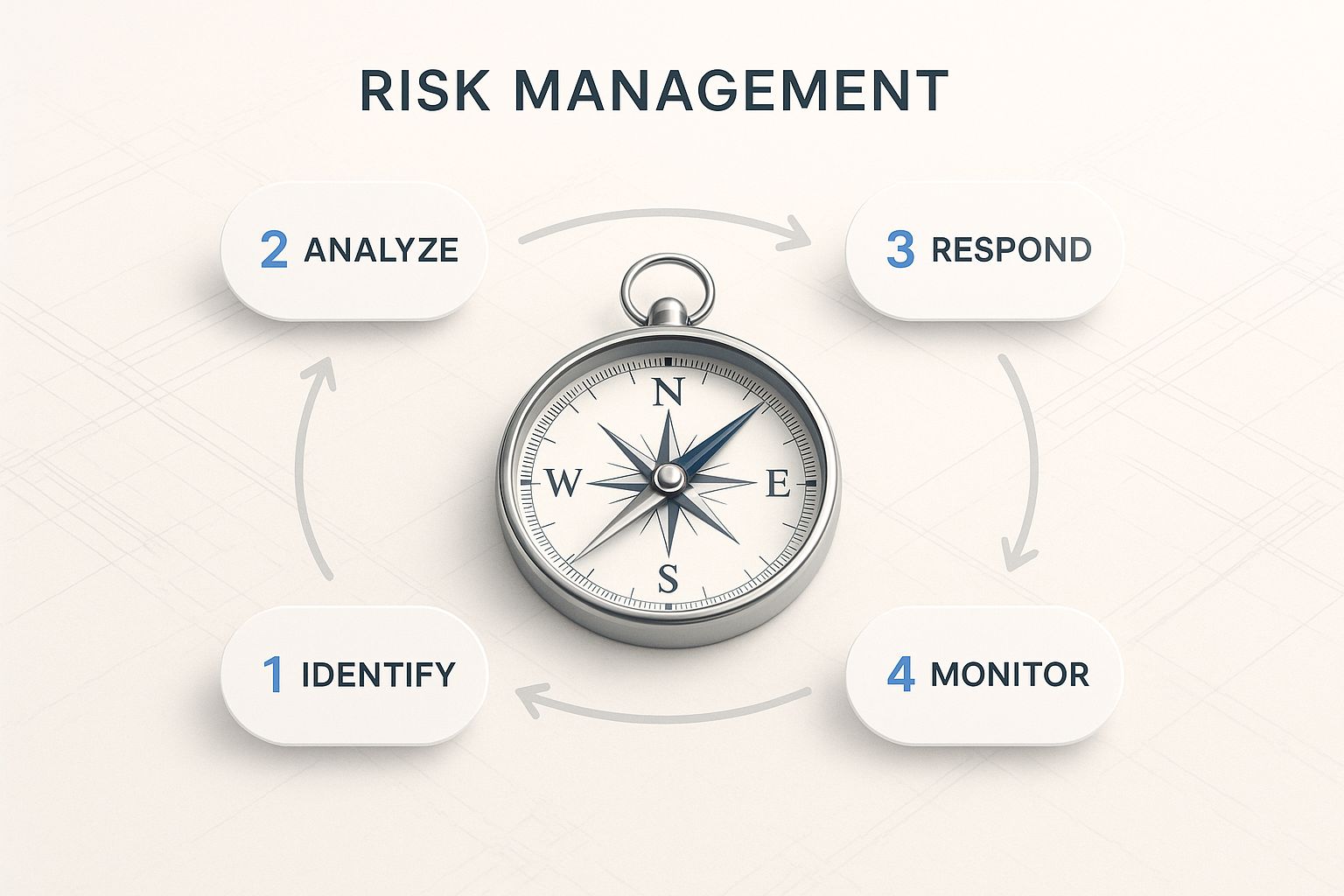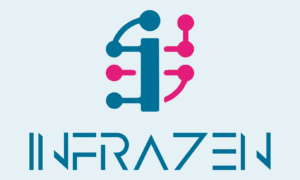Life cycle risk management isn't just another buzzword; it's a fundamental shift in how we handle threats. It’s a proactive strategy for spotting and dealing with potential problems throughout the entire journey of a project or product-from the first flicker of an idea all the way to its final retirement.
This approach transforms risk management from a reactive, fire-fighting exercise into a strategic advantage that builds long-term resilience and practically guarantees a better outcome.
Understanding the Core of Life Cycle Risk Management

Imagine you're launching a new software feature. The traditional way of thinking might zero in on the development phase-things like coding bugs or missed deadlines. But that perspective is dangerously narrow. It completely ignores what comes before and after.
Life cycle risk management zooms out. It forces us to ask tough questions at every single stage. What are the risks during conceptualisation? What about during the launch? What happens years down the line when we need to retire the feature? This forward-thinking method accepts a simple truth: risks aren't static. They evolve, disappear, and pop up unexpectedly as a project matures.
Why a Full Life Cycle View Matters
Ignoring the bigger picture is like being a ship's captain who only checks the weather at the port. Smooth sailing at the start means very little if you're unprepared for the storm brewing mid-journey or the tricky docking challenges at your final destination. A holistic approach prepares you for the entire voyage, not just the departure.
This process is all about continuous evaluation, not a one-off check-box exercise. Research has shown that a huge number of security incidents happen between scheduled assessments, which just goes to show why ongoing vigilance is so critical. By adopting a life cycle perspective, your team can start anticipating challenges instead of just reacting to them.
Key Benefits of This Approach
Adopting a life cycle risk management framework brings real, tangible advantages that protect your projects and make your entire organisation stronger. It moves your team from a defensive crouch to a confident, strategic stance.
- Proactive Problem Solving: When you spot potential issues early in the concept phase, you can design solutions before they blow up into costly emergencies.
- Improved Resource Allocation: Understanding the risks at each stage helps you put your budget, time, and talent exactly where they're needed most, preventing waste on low-priority threats.
- Enhanced Stakeholder Confidence: A structured plan for managing risks shows foresight and competence. It’s a powerful way to build trust with clients, investors, and your own internal teams.
- Greater Project Success: At the end of the day, anticipating and tackling threats throughout a project's life directly contributes to hitting your goals on time and within budget.
A life cycle approach fundamentally changes the goal of risk management. It’s no longer just about preventing failure; it's about actively engineering success by understanding the full journey of a product or project from beginning to end.
Think about how a brand’s public image requires constant attention. A comprehensive reputation management guide explains this perfectly, detailing the need for ongoing monitoring, crisis response, and proactive growth-a true life cycle strategy. This is the mindset that underpins modern, effective risk management.
The Core Principles of Life Cycle Risk Management
To make this work, you need to build on a few foundational ideas. These principles guide the entire process, ensuring it remains consistent, effective, and aligned with your goals from start to finish.
| Principle | Description |
|---|---|
| Integrated Process | Risk management isn't a separate task; it's woven into every decision, meeting, and project phase. |
| Proactive Mindset | The focus is always on anticipating future risks, not just documenting past failures. |
| Continuous Evaluation | Risks are constantly monitored and reassessed, because what's a small issue today could be a crisis tomorrow. |
| Comprehensive Scope | The process covers everything from tiny operational details to major strategic threats, leaving no stone unturned. |
| Customised Approach | Every project is unique, so the risk management plan must be tailored to its specific goals, context, and stakeholders. |
By embedding these principles into your team's culture, you create a system that is robust, adaptable, and genuinely useful for steering projects towards success.
Navigating the Four Stages of Risk Management
Effective life cycle risk management isn’t a one-off task; it's a continuous, repeating process. Think of it as an engine that keeps your projects running smoothly, helping your team make proactive decisions from kickoff to delivery. The whole thing is best understood as a dynamic loop with four distinct but interconnected stages.
Let's imagine you're part of a creative agency launching a new software feature for a key client. The pressure is on, and failure really isn't an option. This is where the four-stage cycle becomes your roadmap, helping you get ahead of problems instead of just reacting to them.
This infographic shows how the four stages-Identify, Analyse, Respond, and Monitor-form a continuous loop, keeping your project on course.

What the visual makes clear is that these stages aren't a linear checklist. It’s a cycle you have to revisit throughout a project’s life to stay sharp.
Stage One: Risk Identification
The first stage is all about discovery-what could possibly go wrong? This is a creative brainstorming phase, not a time for judgement. Your goal is simply to generate a comprehensive list of potential threats, no matter how unlikely they seem at first.
For our new software feature, your team might come up with risks like:
- A key developer leaving mid-project.
- The final design failing to meet the client's accessibility standards.
- A third-party API becoming unreliable after launch.
- The project scope creeping beyond the original budget and timeline.
This initial list is the foundation for your entire risk management plan. A thorough identification stage prevents you from being blindsided down the road.
Stage Two: Risk Analysis
Once you have your list, it's time to analyse each risk. Not all threats are created equal, and this step helps you separate the minor headaches from the project-derailing catastrophes. The main task here is to evaluate two things for each risk: the probability of it happening and the potential impact if it does.
A high-probability, low-impact risk (like a minor typo in the user interface) is far less concerning than a low-probability, high-impact one (like a critical server failure). Using a simple matrix to plot these factors helps your team prioritise its focus and allocate resources intelligently. You tackle the biggest threats first.
The point of analysis isn't to predict the future with perfect accuracy. It's to make informed judgements that guide your attention toward the risks that truly matter, so your team doesn't waste energy on trivial issues.
Stage Three: Risk Response
Now you know which risks are most critical, it’s time to decide what to do about them. This is the risk response phase, where you build a clear plan of action. Generally, there are four main strategies your team can take.
- Avoid: Change the project plan to eliminate the risk entirely. For instance, if a new, untested technology is a risk, you might switch to a more established and reliable alternative.
- Mitigate: Take steps to reduce the probability or impact of the risk. To mitigate the risk of a developer leaving, you could ensure project documentation is impeccable so someone else can step in smoothly.
- Transfer: Shift the financial impact of the risk to a third party. A classic example is buying insurance to cover potential data breaches or liability claims.
- Accept: For low-impact risks, the most sensible approach might be to do nothing and simply accept its potential occurrence. The cost of dealing with the risk might outweigh the potential damage.
Choosing the right response is a strategic decision that balances cost, time, and potential benefit.
Stage Four: Risk Monitoring
Finally, risk management is not a "set it and forget it" activity. The last stage, risk monitoring, is about keeping a watchful eye on everything. This means tracking your identified risks, looking out for new ones that pop up, and checking if your response plans are actually working.
Regular check-ins should be a standard part of your project meetings. Is the probability of a previously identified risk increasing? Did an unforeseen threat emerge? Is your mitigation plan working as expected? This stage feeds directly back into identification, ensuring the risk management cycle remains a living, breathing part of your project. You can explore a detailed breakdown of this continuous process to further sharpen your team's approach. This constant loop of identifying, analysing, responding, and monitoring keeps your strategy relevant and effective from start to finish.
How to Identify Risks at Every Project Phase
Risks aren't static-they change and morph as a project moves from one stage to the next. A threat that seems tiny during the brainstorming phase can balloon into a huge roadblock during development. Smart life cycle risk management is all about seeing these shifts coming and flagging potential issues before they become full-blown crises.
This kind of forward-thinking means looking at the project's journey as a series of distinct stages, each with its own unique risk profile. By knowing what to look for at each step, your team can stop firefighting and start proactively spotting trouble on the horizon.
Risks in the Conceptualisation Phase
This is the "big idea" stage-all about strategy, brainstorming, and initial planning. The risks here are often broad and strategic. If you ignore them, they can sink the entire project before a single line of code is written or a design is mocked up.
At this point, the biggest dangers are misalignment and bad assumptions. Is your team solving the wrong problem? Are you building something for an audience that doesn't actually exist?
Common conceptualisation risks include:
- Poor Market Fit: The idea doesn’t solve a real customer problem, which means you’re building a product nobody wants.
- Unclear Objectives: The project's goals are fuzzy or contradictory, making it impossible to know what success even looks like.
- Inadequate Resourcing: The budget, timeline, or team's skill set just isn't enough for the project's scope.
- Strategic Misalignment: The project doesn't actually support the organisation's wider goals.
Risks in the Development and Implementation Phase
Once the project moves into active development, the risks get a lot more tangible and technical. This is where the plan hits reality, and all sorts of unforeseen complexities can pop up. The focus shifts from, "Are we building the right thing?" to, "Are we building the thing right?"
Technical snags, internal team friction, and third-party dependencies are the usual suspects here. A small bug or a missed dependency can cause massive delays and budget blowouts if you don't catch it early.
Typical development risks include:
- Technical Roadblocks: The tech you chose isn't up to the job, or unexpected integration problems bring things to a halt.
- Scope Creep: The project's requirements expand without control, stretching resources thin and pushing back deadlines.
- Team and Skill Gaps: A key person leaves, or the team realises they lack the specific expertise needed to solve a problem.
- Dependency Failures: A third-party supplier or an essential API fails to deliver, stopping progress in its tracks.
The best way to handle development-phase risks is through constant communication and iterative progress. Regular check-ins and a culture of transparency let teams flag problems early, when they're still small and easy to fix.
Risks in the Launch and Maturity Phase
When a project finally launches and starts to mature, the risks pivot from internal execution to external reception and long-term survival. How will customers react? Can we actually support this thing? Will it still be relevant in a year?
This final stage is where the product's real value is put to the test. Negative feedback, competitive pressure, and technology becoming obsolete are major threats that demand constant monitoring and adaptation.
Consider these post-launch risks:
- Negative Customer Reception: The launch fizzles out, or early user feedback is overwhelmingly bad.
- Operational Failures: The support systems can't cope with the number of users, leading to a frustrating customer experience.
- Competitive Threats: A competitor launches a better product or slashes their prices, eating into your market share.
- Becoming Obsolete: The technology or approach you used becomes outdated, making your product irrelevant.
Simple Tools for Comprehensive Risk Identification
To get a complete picture of potential threats, your team can use a few simple but powerful tools. These techniques force structured thinking and collaboration, making sure no stone is left unturned. A brainstorming session is a good start, but a SWOT analysis-Strengths, Weaknesses, Opportunities, Threats-provides a more formal framework.
Ultimately, the goal is to create a risk register-a central document that lists every risk you've identified. This register isn't a one-and-done document; it's a living file your team updates throughout the entire project.
To ensure your register is thorough, especially when it comes to digital threats, using a structured guide can be a game-changer. You can learn more about building a solid foundation with a cybersecurity risk assessment template that helps organise and prioritise potential vulnerabilities. This structured approach ensures your life cycle risk management efforts are both comprehensive and actionable.
Analysing and Prioritising Identified Risks
Identifying every possible risk is a great start, but it usually leaves you with a long, frankly overwhelming, list. The real trick to life cycle risk management isn't just knowing what could go wrong-it's deciding which threats actually deserve your immediate attention. Without a clear way to sort through the noise, you can easily waste valuable time and resources on minor issues while a major catastrophe brews unnoticed.
This is where risk analysis comes in. It’s a structured way of evaluating the potential severity of each threat, letting you move from a chaotic list to an organised, actionable plan. It’s about making smart decisions based on data, not just reacting to whoever shouts the loudest in a meeting.
Introducing the Probability-Impact Matrix
One of the simplest and most effective tools for this job is the probability-impact matrix. Think of it as a simple grid that helps you classify risks based on two key dimensions: the likelihood of the risk happening and the potential impact it would have if it did. It's a fantastic visual tool for separating the genuine dangers from the trivial distractions.
By plotting each risk on this matrix, you can quickly see which ones land in the high-probability, high-impact quadrant. These are your top priorities-the red flags that demand immediate and robust response plans.
Let's ground this in a real-world scenario, like a mobile app development project:
- A critical data breach: This has a low probability but a catastrophic impact. A breach could lead to massive fines, reputational ruin, and a complete loss of customer trust. It lands squarely in the high-priority zone.
- A minor cosmetic bug: Imagine a button that's slightly misaligned on certain devices. This has a high probability of happening but a very low impact. It’s an annoyance, not an emergency, and can be fixed when time permits.
This simple classification brings instant clarity. It focuses your team’s energy on protecting sensitive data rather than getting bogged down by minor visual tweaks.
Moving Beyond Gut Feelings
The real power of the probability-impact matrix is how it forces objective, data-driven conversations. It makes the team articulate why they think a risk is likely or impactful, which builds a shared understanding of the project's weak spots. This structured approach helps get everyone, from developers to stakeholders, on the same page.
The goal of risk analysis isn't to eliminate uncertainty entirely-that’s impossible. It's to manage it intelligently by focusing your limited resources on the threats that pose the greatest danger to your project's success.
To manage a long list of risks and spend your resources wisely, it's crucial to employ essential prioritization techniques. These methods provide structured frameworks that build on what the probability-impact matrix tells you, helping teams make even sharper decisions.
This kind of structured analysis is a core part of any well-defined governance strategy. To see how this fits into the bigger picture, you can explore our guide on building an IT governance framework, which shows how risk analysis informs wider organisational policies and controls. By systematically analysing and prioritising, you transform your risk register from a simple list into a strategic roadmap for navigating the entire project life cycle.
Risk Management in Real-World Scenarios

Theory is one thing, but seeing risk management deliver results out in the wild is where its value truly clicks. The principles of spotting, analysing, and tracking risks over a project’s entire duration aren't just for boardroom presentations. They’re just as relevant to personal planning, organisational safety, and long-term financial stability.
By looking at a couple of tangible examples, we can see just how this structured approach to uncertainty pays off. These scenarios show the universal benefit of a forward-thinking risk strategy, whether you're mapping out your own future or steering a large organisation. Let’s explore how it works in two completely different worlds: personal finance and workplace safety.
Personal Financial Planning for a Longer Life
In the UK, life cycle risk management is absolutely crucial for personal finance, mainly because we’re all living longer. This demographic shift introduces massive long-term risks to our retirement savings, healthcare funding, and estate planning. A financial plan you cooked up at 30 is almost guaranteed to be obsolete by the time you're navigating your 80s or 90s.
The numbers don't lie. According to the UK Office for National Statistics, life expectancy has climbed steadily. Women born in 2014 are expected to live to 83 on average, and men to 79-a huge jump from 75 and 70 respectively back in 1981. This "longevity risk" means retirement pots need to stretch further, and the odds of needing expensive long-term care go up dramatically.
A life cycle approach to your finances breaks it down into stages:
- Early Stage (Career Building): The big risks here are job instability and not saving enough. You mitigate these by building an emergency fund and diversifying your investments early on.
- Mid-Stage (Pre-Retirement): Your focus shifts to market swings and inflation eating into your savings. The strategy is to gradually de-risk your portfolio and pump as much as you can into your pension.
- Late Stage (Retirement): Now, the main dangers are outliving your savings and facing rising healthcare bills. This calls for smart withdrawal strategies and maybe even looking into long-term care insurance.
This isn’t a one-and-done plan; it's a continuous process that adapts as your life changes, ensuring your financial strategy never goes stale.
Ensuring Workplace Safety in Manufacturing
Now, let's switch gears to an industrial setting. A manufacturing firm can use the exact same life cycle principles to keep its employees safe-not just for one project, but across an entire career. Here, the "life cycle" is the employee's whole tenure, from their first day on the job to their retirement party.
The goal is to create an environment where safety risks are anticipated and managed at every stage of an employee's journey, recognising that the hazards they face will evolve with their role and experience.
Think about it. A new hire’s biggest risk is not being familiar with the machinery. The fix? Intensive training and close supervision. Fast-forward ten years, and that same employee might be a supervisor. Their risks have completely changed; now it’s about complacency or failing to enforce safety rules for their team. The mitigation strategy evolves, too, shifting to leadership training and reinforcing a strong safety culture.
This approach acknowledges that a static safety manual gathering dust on a shelf is useless. To see how a business can effectively overhaul its core operations and tackle similar evolving challenges, you might find this case study on transforming IT infrastructure for growth insightful. Just as IT systems must adapt, so must safety protocols to address the changing risks an employee faces over a 30-year career.
Building a Culture of Risk Awareness
Even the most meticulous life cycle risk management plan is just a document. It’s the team on the ground that brings it to life. While tools and processes give you a framework, it's a culture of proactive risk awareness that makes the difference day-to-day.
This isn’t about building a team that shies away from every risk-that’s a creative dead-end. It's about empowering your people to be prepared, agile, and confident enough to make smart, calculated decisions when it matters most.
This shift starts with open communication. Discussions about risk need to be a normal, blame-free part of your project meetings, not some taboo topic dragged out only after something has gone wrong. When people feel safe to flag a potential issue without fearing blame, you unlock the collective wisdom of your entire team.
Foster Psychological Safety
A blame-free environment is non-negotiable. It’s the bedrock of a risk-aware culture.
When mistakes are treated as learning opportunities instead of failures, people are far more likely to speak up early. This creates psychological safety, encouraging transparency and stopping small problems from quietly spiralling into disasters.
To get there, leaders have to model the behaviour. Acknowledge your own uncertainties, actively ask for input on potential risks, and thank team members for flagging concerns-even if they turn out to be nothing. This creates a space where vigilance is genuinely valued.
The goal isn’t to create a risk-averse team, but a risk-intelligent one. A culture of awareness empowers people to take thoughtful risks, backed by a clear understanding of the potential downsides and a plan to deal with them.
Define Clear Risk Ownership
Vague responsibility is a massive vulnerability in any plan. If everyone is responsible, nobody is.
Effective risk management demands that you clearly define who owns each risk you identify. This doesn't mean one person is left to fix it alone. It means they are accountable for monitoring that risk and spearheading the response if it materialises.
Assigning ownership ensures nothing slips through the cracks. It provides a clear point of contact, drives accountability, and transforms a passive list of worries into an active management plan.
Here are a few practical steps to start embedding this culture now:
- Make it a meeting habit. Add a "risks and roadblocks" item to your weekly team meeting agenda. This simple change normalises the conversation.
- Run project retrospectives. After a project wraps up, hold a proper "lessons learned" session. Discuss what went well, which risks actually happened, and how you could improve the response next time.
- Celebrate the good calls. Publicly acknowledge when a team member's early warning helped you dodge a bullet. This reinforces the value of being proactive and proves you mean it.
Got Questions? We’ve Got Answers.
Jumping into life cycle risk management can feel a bit daunting, so it’s natural to have a few questions. Here are some straightforward answers to the things people usually ask, designed to clear up any confusion and help you put these ideas into practice.
What’s the Main Difference Between Risk Management and Crisis Management?
Think of it like this: risk management is your preventative health plan. It’s all the proactive stuff you do-like eating well and getting regular check-ups-to stay healthy and avoid getting sick in the first place.
Crisis management, on the other hand, is the emergency room. It’s the reactive, high-stakes response after something has already gone wrong. Life cycle risk management is the ongoing strategy to keep you out of the A&E; crisis management is the plan for what to do when you end up there anyway.
How Often Should We Revisit Our Risk Assessment?
A risk assessment isn’t a one-and-done document you file away and forget. It needs to be a living, breathing part of your project.
For a high-stakes project, you might need to look at it every month. For something less critical, a quarterly review might be fine. The real trigger for a review is change. If a new team member joins, the budget shifts, or the scope of the project gets an update, it's time to reassess. Continuous monitoring is what keeps risk management effective.
The rule of thumb is simple: your risk assessment should be as dynamic as your project. If things are changing on the ground, your understanding of the risks needs to change with them.
Is This Process Only for Large, Complex Projects?
Not at all. While it’s absolutely essential for big, complex initiatives, the core principles scale down beautifully. Even a solo freelancer planning a small client job can benefit from thinking through what could go wrong at each stage-from the initial pitch to final delivery and getting paid.
The level of formality might change, but the mindset of anticipating problems and having a plan is valuable for everyone. It leads to smoother projects, happier clients, and far fewer last-minute panics, no matter the scale of the work.
Can We Ever Eliminate All Risks?
Nope, and that’s not even the goal. Trying to create a completely risk-free environment is impossible, especially in any creative or business venture. The real aim of life cycle risk management is to make risk-intelligent decisions.
It's about knowing what could go wrong, focusing on the threats that matter most, and having a solid plan to deal with them if they happen. This gives your team the confidence to take smart, calculated risks, knowing you’ve got a safety net in place.
At InfraZen Ltd, we believe proactive technology management is the smartest way to handle risk. We help creative teams build resilient IT systems that prevent downtime and protect your most valuable assets, so you can focus on your work with confidence. Discover how our ZenCore plans can secure your creative workflow at https://infrazen.tech.

